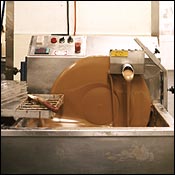
Building your own chocolate factory isn’t easy. Jacques Torres, who has a store in Dumbo and is probably the city’s most esteemed chocolatier, has been working on his Chocolate Haven (at 350 Hudson Street in Soho) for months, but equipment hassles delayed the opening. (Latest estimate: “Early November.”) When it does open, Torres will be the only New York chocolatier to make his own bars from scratch. To whet our appetites, he outlined his process. Brave souls who can’t wait can try it at home—good luck.
1. The Ingredients. The most important ingredient is cocoa beans, and the best ones are grown twenty degrees north and south of the equator—I like the beans from Trinidad, Venezuela, Madagascar. It’s a lot like wine. You might be looking for a spicy bean, or a bean with a particular roundness or fullness. Vanilla is also key—Tahiti is the best place to buy it.
2. The Preparation. We fumigate the dried cocoa beans to kill any insects, then sort them to remove any remaining little stones or metal. Then we put the beans into a roaster to completely decontaminate them; cocoa beans are pretty dirty. When they come out we put them into a winnower, which lightly breaks the beans and removes the shells.
3. The Mixture. Now you’re left with what are called nibs—broken bits of cocoa bean. We pass the nibs through a grinder to turn them into a paste. When the product comes out, we mix the paste with vanilla, sugar, powdered milk if necessary, and nuts, if that’s what we’re making. Sometimes we add some cocoa butter to make it feel smoother in the mouth. The added fat makes the chocolate a lot creamier.
4. The Refinement. The refiner has three to five steel rolls that turn in opposite directions, like a clothes cranker. It crunches the chocolate to less than twenty microns, which is the point at which you cannot feel any granulations on your tongue. Very, very thin. At that stage, it goes into a conch—a granite-lined bowl with granite and stainless-steel wheels that churn the chocolate very strongly for 24 to 48 hours. This removes the bitterness.
5. The Final Touch. Then we add a little bit of lecithin to the chocolate. Lecithin comes from soy, and it helps to emulsify and bond the ingredients. When the chocolate comes out of the conch, it goes into a tank where we can cool it down and mold it into whatever we like.
6. The Molding. After the chocolate has been made, it goes into a machine to be shaped and coated.